Navigation
Dragonflies: The Flying Aces of the Insect World
With support from the National Science Foundation (NSF), Stacey Combes, a biomechanist at Harvard University, and her team are studying how dragonflies pull off complicated aerial feats that include hunting and mating in mid-air.
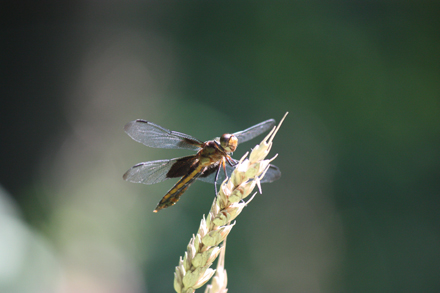 |
| Dragonfly in New York State, July 2011 Photograph by Janine Selendy |
Next time you see a dragonfly, try to watch it catch its next meal on the go. Good luck!
***Dragonflies in flight video at botom of article***
"Unless we film it in high speed, we can't see whether it caught the prey, but when it gets back to its perch, if we see it chewing, we know that it was successful," says Stacey Combes, a biomechanist at Harvard University. With support from the National Science Foundation (NSF), she and her team are studying how dragonflies pull off complicated aerial feats that include hunting and mating in mid-air. She set up her lab in typical "dragonfly country."
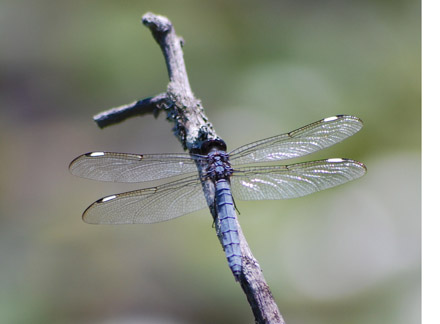 |
| Dragonfly perching on branch. Photograph courtesy of Combes Lab, Concord Field Station, Harvard University |
"Our lab is at the Concord Field Station in Bedford, Mass. This is a field station of Harvard University about a half-hour from the main campus," says Combes. "We're surrounded by woods and ponds, which is an ideal habitat to find dragonflies."
The researchers have already identified 20 species at the pond so far. On this outing, they hope to net a few to study. But, it's not easy to catch a dragonfly.
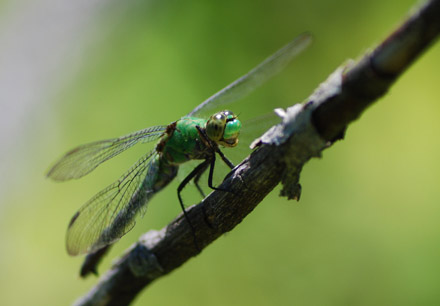 |
| Dragonfly. Photograph courtesy of Combes Lab, Concord Field Station, Harvard University |
"Alright, I got one ... I lost it," exclaims team member and biomechanist Jay Iwasaki. "It's a Libellula cyanea," he notes when he finally catches one. "It's in the family of Libellulidae, which are dragonflies known as skimmers; this is a male. You can tell this species in particular from the white dots on its wings."
The team takes two dragonflies back to a specially built, netted enclosure. It's large, about one and a half stories high. "We built this especially to look at predation in dragonflies. One of the problems with studying dragonflies is they tend to not go after prey if the lighting is not just right. If they're not in a large enough space where they're comfortable, they'll just starve because they only will eat this prey in midair," explains Combes.
In the enclosure, her team has set up eight high-speed cameras. They release a dragonfly along with some tasty fruit fly prey to see what happens next. The high-speed cameras catch what the human eye can't.
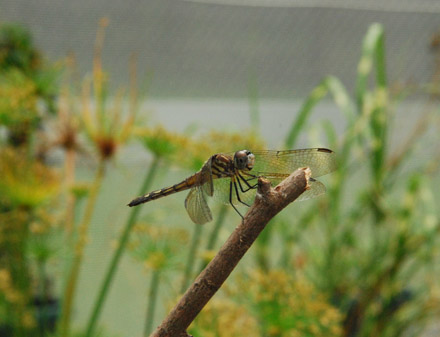 |
| Perched dragonfly. Photograph courtesy of Combes Lab, Concord Field Station, Harvard University |
"They'll go up in midair, catch the prey with their feet, turn upside down and glide back to the stick, and the whole capture will take maybe a second, or a second and a half," says Combes. She points to one of the high-speed images: "This one is missing about half of its left front wing and yet, it still does an amazing job catching the fruit fly in midair."
"That particular maneuver takes only a half second to happen," adds Iwasaki.
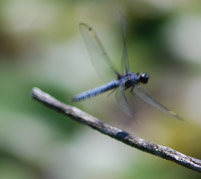 |
| Dragonfly taking off. Photograph courtesy of Combes Lab, Concord Field Station, Harvard University |
"They're amazing fliers," explains Combes. "They're fun to watch and it's something you can't really see with your naked eyes. We look at them in high speed and look at the angles in flight as they catch prey. They flip upside down, it's just amazing and they do it time after time, hundreds of times, like it's nothing. In the enclosure they caught about 90 percent of the prey that we gave them."
Dragonflies have had a long time to evolve their skills as predators. They have been on the planet for about 300 hundred million years and predate dinosaurs. They can fly straight up, straight down, hover like helicopters and disappear in a blur.
"Dragonflies have two sets of wings and they flap in different phases," says Combes. "Sometimes they flap together; sometimes they're offset and we're seeing with our predation videos that they change this all the time."
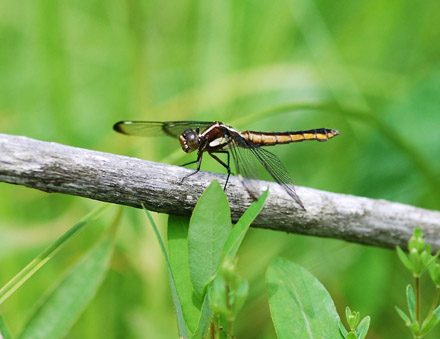 |
| Dragonfly. Photograph courtesy of Combes Lab, Concord Field Station, Harvard University |
Biomechanist Amber DesLauriers points to a dragonfly sitting on a thick blade of grass. You can see its head moving back and forth looking for its next meal. "They can pretty much see all the way around their head except right behind them," she says.
Combes says engineers are looking to the dragonfly for inspiration in small-scale aircraft design. "There's a lot of interest in building small robotic devices and when you get down to the size scale of insects, you really can't build mini airplanes. The physics don't work well to have a little, tiny airplane. You really need to have flapping or rotating wings. So, we can learn a lot from these insects," she explains.
Combes is also exploring the idea of using dragonflies for mosquito control. "They may consume 30 mosquitoes a day. They could even consume hundreds a day," she notes.
This article is from National Science Foundation (NSF) Science Nation reported by Miles O'Brien, Science Nation Correspondent and Ann Kellan, Science Nation Producer, 3 October 2011.
Note:
See related article regarding dragonflies and mosquito control on Horizon International's Solutions Site Prospects for suppressing dengue transmission by means of biological agents.
By Professor Andrew Spielman*
Harvard School of Public Health
Excerpt:
"Other predatory insects have been used to reduce the abundance of A. aegypti mosquitoes. Dragonfly larvae, in particular, may be useful for this purpose (Sebastian et al. 1990). In this Myanmar (=Burma) experiment, numerous larval Crocothemis servila, a pond-dwelling libellulid, were reared from field derived adults.
Larval mosquitoes were provided as food to maintain these subadult dragonflies prior to their release into containers of potable water in the treated community. Target larvae virtually disappeared immediately after 2 dragonflies were placed in each container, and the density of target adults declined about 6 weeks later.
Although no explanation for this delay in the suppression of adults is evident, the experiment is considered as a success. These observations suggest that a predator that is satisfactory for use in tanks of potable water must be large enough to consume many larvae in a short time, cling to the sides of the container so that it will not be lost when water is removed, develop slowly enough that it need not be replaced frequently and be able to survive for months when no larval mosquitoes are available as food.
This model dragonfly release effort may be too expensive to serve as a basis for operational anti-dengue programs, particularly where our "throw-away society" provides alternative breeding sites that may be too small, numerous and difficult to identify. "
*Deceased December 2006
Video from the National Science Foundation (NSF) Science Nation
Search
Latest articles
Agriculture
- World Water Week: Healthy ecosystems essential to human health: from coronavirus to malnutrition Online session Wednesday 24 August 17:00-18:20
- World Water Week: Healthy ecosystems essential to human health: from coronavirus to malnutrition Online session Wednesday 24 August 17:00-18:20
Air Pollution
- "Water and Sanitation-Related Diseases and the Changing Environment: Challenges, Interventions, and Preventive Measures" Volume 2 Is Now Available
- Global Innovation Exchange Co-Created by Horizon International, USAID, Bill and Melinda Gates Foundation and Others
Biodiversity
- It is time for international mobilization against climate change
- World Water Week: Healthy ecosystems essential to human health: from coronavirus to malnutrition Online session Wednesday 24 August 17:00-18:20
Desertification
- World Water Week: Healthy ecosystems essential to human health: from coronavirus to malnutrition Online session Wednesday 24 August 17:00-18:20
- UN Food Systems Summit Receives Over 1,200 Ideas to Help Meet Sustainable Development Goals
Endangered Species
- Mangrove Action Project Collaborates to Restore and Preserve Mangrove Ecosystems
- Coral Research in Palau offers a “Glimmer of Hope”
Energy
- Global Innovation Exchange Co-Created by Horizon International, USAID, Bill and Melinda Gates Foundation and Others
- Wildlife Preservation in Southeast Nova Scotia
Exhibits
- Global Innovation Exchange Co-Created by Horizon International, USAID, Bill and Melinda Gates Foundation and Others
- Coral Reefs
Forests
- NASA Satellites Reveal Major Shifts in Global Freshwater Updated June 2020
- Global Innovation Exchange Co-Created by Horizon International, USAID, Bill and Melinda Gates Foundation and Others
Global Climate Change
- It is time for international mobilization against climate change
- It is time for international mobilization against climate change
Global Health
- World Water Week: Healthy ecosystems essential to human health: from coronavirus to malnutrition Online session Wednesday 24 August 17:00-18:20
- More than 400 schoolgirls, family and teachers rescued from Afghanistan by small coalition
Industry
- "Water and Sanitation-Related Diseases and the Changing Environment: Challenges, Interventions, and Preventive Measures" Volume 2 Is Now Available
- Global Innovation Exchange Co-Created by Horizon International, USAID, Bill and Melinda Gates Foundation and Others
Natural Disaster Relief
- STOP ATTACKS ON HEALTH CARE IN UKRAINE
- Global Innovation Exchange Co-Created by Horizon International, USAID, Bill and Melinda Gates Foundation and Others
News and Special Reports
- World Water Week: Healthy ecosystems essential to human health: from coronavirus to malnutrition Online session Wednesday 24 August 17:00-18:20
- STOP ATTACKS ON HEALTH CARE IN UKRAINE
Oceans, Coral Reefs
- World Water Week: Healthy ecosystems essential to human health: from coronavirus to malnutrition Online session Wednesday 24 August 17:00-18:20
- Mangrove Action Project Collaborates to Restore and Preserve Mangrove Ecosystems
Pollution
- Zakaria Ouedraogo of Burkina Faso Produces Film “Nzoue Fiyen: Water Not Drinkable”
- "Water and Sanitation-Related Diseases and the Changing Environment: Challenges, Interventions, and Preventive Measures" Volume 2 Is Now Available
Population
- "Water and Sanitation-Related Diseases and the Changing Environment: Challenges, Interventions, and Preventive Measures" Volume 2 Is Now Available
- "Water and Sanitation-Related Diseases and the Changing Environment: Challenges, Interventions, and Preventive Measures" Volume 2 Is Now Available
Public Health
- Honouring the visionary behind India’s sanitation revolution
- Honouring the visionary behind India’s sanitation revolution
Rivers
- World Water Week: Healthy ecosystems essential to human health: from coronavirus to malnutrition Online session Wednesday 24 August 17:00-18:20
- Mangrove Action Project Collaborates to Restore and Preserve Mangrove Ecosystems
Sanitation
- Honouring the visionary behind India’s sanitation revolution
- Honouring the visionary behind India’s sanitation revolution
Toxic Chemicals
- "Water and Sanitation-Related Diseases and the Changing Environment: Challenges, Interventions, and Preventive Measures" Volume 2 Is Now Available
- Actions to Prevent Polluted Drinking Water in the United States
Transportation
- "Water and Sanitation-Related Diseases and the Changing Environment: Challenges, Interventions, and Preventive Measures" Volume 2 Is Now Available
- Urbanization Provides Opportunities for Transition to a Green Economy, Says New Report
Waste Management
- Honouring the visionary behind India’s sanitation revolution
- Honouring the visionary behind India’s sanitation revolution
Water
- Honouring the visionary behind India’s sanitation revolution
- Honouring the visionary behind India’s sanitation revolution
Water and Sanitation
- Honouring the visionary behind India’s sanitation revolution
- Honouring the visionary behind India’s sanitation revolution

